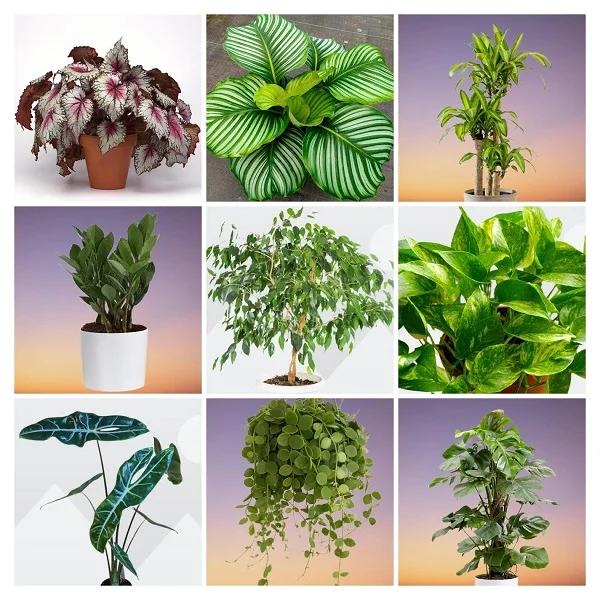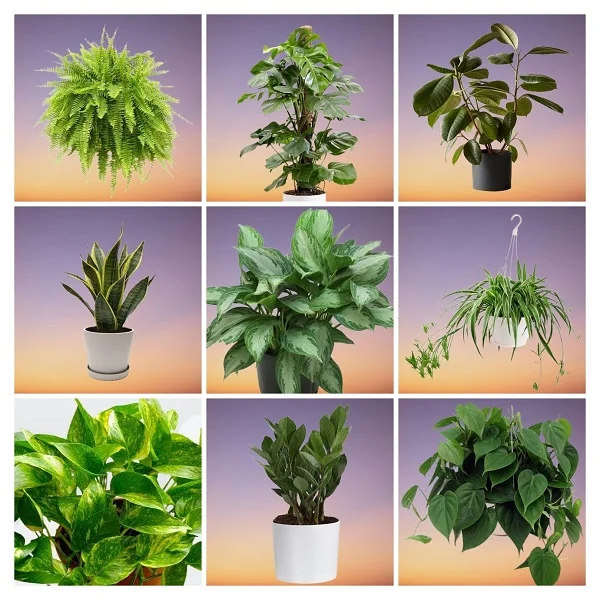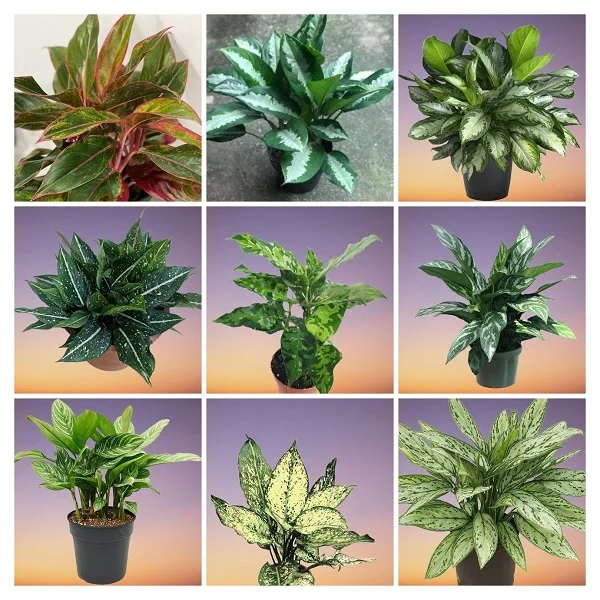How to Grow, Care for and Propagate Caladium hortulanum
Some links in this post may be affiliate links
Caladium hortulanum grows best in medium to bright indirect light, warm and humid conditions and moderately moist, well-drained, rich soils coupled with regular feeding in the growing season.
Caladium hortulanum commonly called Caladium, Elephant Ear, Angel Wings or Heart of Jesus Plant bear striking arrow-shaped, paper thin and beautifully marked leaves.
The common colors are white, pink and red. This dazzling Caladium foliage only lasts a short time from late spring to early autumn. Thereafter, the foliage dies and the plant goes dormant which is a natural characteristic of this plant.
Heart of Jesus Plant grows from tubers (bulbs) which can be saved after the foliage dies to be replanted in the next year to propagate new plants.

Botanical name: Caladium hortulanum
Family: Araceae
Common names: Caladium, Elephant Ear, Angel Wings, Heart of Jesus Plant
Origin
Caladium genus comprises of about 7 species which are native to South America and Central America and naturalized in India, parts of Africa and various tropical islands.
In their native habitat, Heart of Jesus Plants grow in the open areas of the forest and on banks of rivers and go dormant during the cold season.
Size
In the wild Caladiums can grow to a height of 1-2 feet, while the leaves can be 6-18 inches long and broad. In cultivation most cultivars grow to about 24 inches high and 24 inches wide, although there are dwarf varieties in cultivation now. Caladiums are amongst the best large-leafed plants that create a spectacle in any space.
Varieties
There are over 1000 named cultivars of Caladiums which include Caladium Blushing Bride, Caladium Broken Heart, Caladium Burning Heart, Caladium candidum, Caladium Cranberry Star, Caladium Dawn to Dusk, Caladium Daydreamer among others. Take a look at these Caladium plants varieties.
Is Caladium hortulanum toxic?
Yes. All parts of Caladium hortulanum are toxic to both humans and pets as outlined by ASPCA. If ingested, they may cause burning in the mouth and throat, drooling, vomiting, diarrhea and abdominal pains. Contact with the sap may cause skin dermatitis in sensitive skin. Therefore, always wear gloves when handling Caladiums.
Where to Buy
Caladiums are a great addition in any plant collection. You may acquire Caladiums bulbs (tubers) online from Amazon (Link to Amazon).
How do you care for Caladium hortulanum indoors?
To care for Caladium hortulanum indoors, provide medium to bright indirect light, average warmth of 15-260C, humidity of 55-65% and moderately moist, well-drained soils coupled with regular feeding during the growing season.
Caladiums care requires regular pruning to keep them neat and discourage pest and disease infestation. Repotting is not need as they undergo dormancy during the cold season. Replace the soil at the beginning of the growing season. Keep reading for more on these growing conditions and how to achieve them.
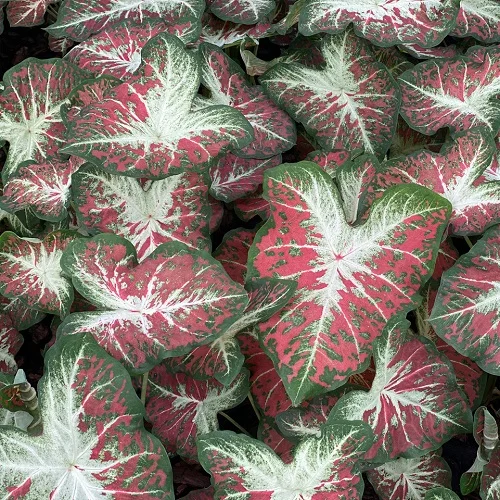
Watering
How often should I water Caladiums?
Water your Caladiums liberally in spring and summer while allowing the top 2-3 inches to dy out between waterings. Do not allow the soil to dry out completely as underwatering can result in drooping and yellowing leaves.
Maintain the soil moderately moist through out and avoid overwatering to prevent yellowing leaves and mushy stems.
Use water that is at room temperature as too cold water may lead to reduced growth and death of the plant.
Make sure that the pot has a drainage hole and the soil is well-draining to prevent waterlogging which can result in rotting of the tubers.
Do not water in fall and winter as the plant is in the dormancy stage and does not need the water.
Light Requirements
Where should I place my Caladium?
Caladium grows best in medium to bright indirect light (filtered light). Place it near a large, bright window away from direct sunlight to prevent scorching of the leaves. Newer varieties with narrower leaves have been developed which can tolerate some direct sunlight.
If the light is too low, Caladiums will become leggy and lose their vibrant leaf colors. Where the natural lighting is not adequate, you may use a full spectrum grow light to supplement it.
Rotate the pot every so often to make sure that the plant receives adequate light on all sides to encourage a balanced growth.
Temperature and Humidity
Caladiums thrive in an average warmth of 15-260C during the growing season. The warmer the temperature the better the growth of the plant.
Keep the plants away from cold drafts; Heart of Jesus Plants cannot tolerate cold drafts as they can signal dormancy which can cause the leaves to die.
Angel Wings Plants require a humidity of 55-65% to thrive. To elevate humidity, set the pot on a wet pebble tray or use a cool mist humidifier. Maintain a free air circulation to discourage fungal diseases.
Fertilizer
What is the best fertilizer for Caladiums?
Caladium needs adequate nutrients for optimal growth. Therefore, regular feeding during the growing season is required.
Feed your Caladiums with a slow release fertilizer at planting time or apply a balanced, liquid fertilizer once a week during the growing period (spring and summer).
Do not feed a Heart of Jesus Plant that is in dormancy as it can lead to fertilizer burn and death of the plant.
Potting Soil
The best soil for Caladiums is a rich, free-draining soil to prevent waterlogging while providing the required nutrients.
Repotting
Repotting a Caladium is not necessary as it lasts only a few months and then goes into dormancy in the cold season (fall and winter). However, replace the soil with fresh soil at the beginning of the growing season (spring).
Pruning & Grooming
Pruning Caladium is simple. Remove yellow and dead leaves to maintain the plant neat and reduce chances of disease and pest infestation. Cut away the dead foliage from the bulbs when growth is over.
Regularly clean the leaves by damp-wiping with a soft cloth to get rid of dust and also discourage pest and disease infestations.
Why is my Caladium dying?
Your Caladium is entering dormancy. This is a natural characteristic of Caladiums where their foliage dies during the cold season (fall to winter) while the underground tubers remain viable and resprout in the next growing season.
How to bring a Caladium back to life?
- After the foliage dies in the cold season, save the tubers (bulbs) to replant them in the next year to propagate new plants.
- Store the tubers in sand or sawdust at a temperature of 15-320C. Temperatures outside this range will cause damage to the tubers which will result in stunted growth of the plants.
- You may also allow the tubers to remain in the same pot until the next growing season. Keep the pot dry; do not water.
- When the temperatures become warmer (early spring), resume watering and new growth will emerge after which you can begin routine care.
Caladium Propagation
How do Caladiums multiply?
Caladiums are multiplied (propagated) by use of tubers (bulbs) at the beginning of the growing season (early spring).
How to propagate Caladiums from tubers (bulbs)
- The large Caladium tubers (bulbs) can be divided into several sections. Ensure each section has at least a node (growing point) from which new growth will sprout.
- Bury the tuber sections about 1 inch deep with the growing point side up in moist, free-draining soil.
- Ensure the pot has a drainage hole to prevent the soil from getting soggy as it can lead to rotting.
- Place the set up in a warm place until growth emerges on the tuber section.
- Allow the new plant to be well established before transplanting after which routine care can begin.
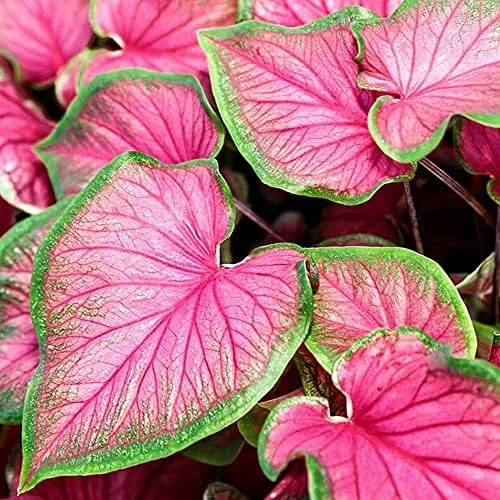
Caladium hortulanum Problems & Solutions
Caladium hortulanum (Heart of Jesus Plant) problems are drooping and yellowing leaves, brown leaves, brown leaf tips and edges, plant dying (dormancy), pests and diseases. Keep reading for more on these problems, their remedies and solutions.
Drooping and yellowing leaves
Why are my Caladium leaves drooping and turning yellow?
Your Caladium leaves are drooping and turning yellow due to inconsistent watering, soggy soil, temperature stress, or too little light.
How to fix it
Inconsistent watering: Do not water on a schedule. Water when the top 2-3 inches of soil dry out but do allow the soil to dry out completely.
Soggy soil: Use a pot with a drainage hole and well-draining soil. Always empty the catch plate after all the excess water has drained.
Temperature stress: Keep the plant away from drafts coming from AC units, heat sources, windy doors among others.
Too little light: Position the plant in medium to bright indirect light or use a grow light if the natural light is not enough.
Brown leaves
Why are the leaves on my Caladium turning brown?
The leaves on your Caladium are turning brown due to direct sunshine, overwatering, soggy soil, pests infestations, and fungal diseases.
How to fix it
Direct sunshine: Move the plant to a shadier spot away from direct sunshine or use a light curtain to filter the sunshine.
Overwatering: Water the plant only when the top 2-3 inches of soil to dry out.
Soggy soil: Use a pot with a drainage hole and well-draining soil. Always discard the excess water from the catch plate.
Pest infestations: Regularly inspect the plant for pests and take timely control measures.
Fungal diseases: Avoid wetting the foliage during watering or water from the bottom instead.
Brown leaf tips and edges
Brown leaf tips and edges on Caladiums are caused by dry air, spider mites infestation, use of hard water, and salts buildup.
How to fix it
Dry air: To raise humidity, set the pot on a wet pebble tray or grow the plant in a well-lit bathroom and other moist areas in the home.
Spider mites infestation: Remove the dead growth and raise humidity to discourage the pests.
Use of hard water: Water the plant with chlorine-free water only like rain water or filtered water.
Salts buildup: Regularly, flush out accumulated salts from the soil by running a stream of water through the soil.
Plant dying (dormancy)
Plant dying is a natural characteristic of Caladiums as they go into dormancy in the cold season (fall to winter). This is when the foliage dies but the bulb remain viable and will sprout when the temperature begin to warm up.
Pests
What are the pests of Caladiums?
Common pests of Caladium are aphids, spider mites, thrips and caterpillars.
How to fix it
- Regularly inspect the plant for ragged leaf margins which is an indication of the presence of pests.
- Isolate the affected plant to reduce spread to other plants.
- Treat the infested plant with neem oil or insecticidal soap as per the manufacturers' recommendations.
- Regularly check between and underneath the leaves for these pests and carry out timely control measures.
- Maintain the plant properly pruned and upscale humidity to discourage pest infestations.
Diseases
Caladium is prone to fungal diseases emanating from dormant tubers. To prevent these diseases, treat the tubers before storage or before planting as follows:
- Immerse the tubers in water heated to 500C for about 30 minutes to destroy any fungi present.
- Thoroughly dry the tubers before storage to avoid rotting.
You liked it? Share on social media.
Related Content
Amazon Associates Disclosure
Homeplantsguide.com is a participant in the Amazon Services LLC Associates Program, an affiliate advertising program designed to provide a means for sites to earn advertising fees by advertising and linking to amazon.com.



